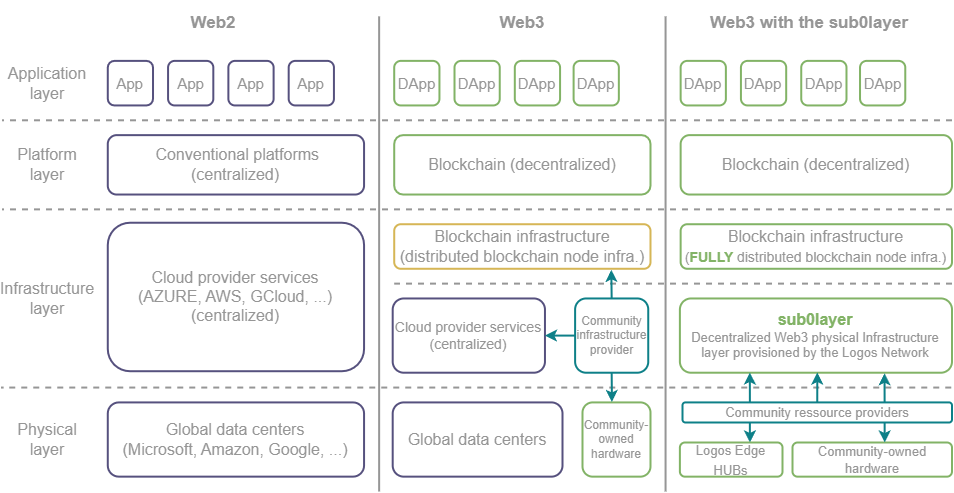Web3 and Logos
The Internet originated in the 1960s as a research project by the U.S. Department of Defense. The precursor to the Internet was ARPANET (Advanced Research Projects Agency Network), which was launched in 1969. The primary goal of ARPANET was to create a network that allowed different computers to communicate with each other, even if parts of the network were disrupted. This design aimed to establish a decentralized structure that would ensure greater reliability and facilitate the exchange of information and research data.
From its inception, ARPANET was built on a decentralized model. There was no central authority; instead, information was sent in small packets through various routes, using the best available paths. This decentralized architecture was crucial to the network's robustness and laid the foundation for what would eventually become the Internet.
Over the following decades, ARPANET evolved into the modern Internet. With the introduction of the World Wide Web (WWW) in the 1990s by Tim Berners-Lee, the Internet became accessible to the general public. The WWW made it easy to access information through linked web pages, leading to an explosion in Internet usage.
Although the Internet was originally decentralized, it has become increasingly centralized over time. Major platforms like Google, Facebook, Amazon, and others now dominate the Internet. These companies control significant portions of web traffic and digital infrastructure, leading to a concentration of power and influence. This centralization contrasts with the original decentralized principles of the Internet and has sparked discussions about new decentralized technologies like Web3, which aim to return control to users and make the Internet more decentralized once again.
World Wide Web
The terms Web, Web2 and Web3 characterize different phases in the development of the World Wide Web.
Each of these terms has its own era with specific technologies, philosophies , models and patterns.
They reflect a jump in the technological development and in the ways in which users interact with the internet.
Web 1.0 (static web): Web 1.0 refers to the early phase of the internet, roughly from the early 1990s to the early 2000s. In this era, websites were largely static and offered limited interactivity. Most users were mere consumers of content created by webmasters or companies. Interactions, if any, were mostly limited to simple forms or e-mail links. Web 1.0 sites mainly served as digital brochures and were not focused on user content generation or social networking.
Web 2.0 (dynamic/social web): The term Web2 started to appear around the mid-2000s, although the year 2004 is often mentioned as the starting point, because Tim O'Reilly and Dale Dougherty from O'Reilly Media came up with the term in a brainstorming session for a conference. Web 2.0 refers to the evolution of the Word Wide Web from a collection of static websites to a dynamic and social platform. It is characterized by increased user interaction, the creation of user-generated content, the development of social networks and the rise of platforms that enable collaboration and sharing (such as blogs, wikis, YouTube, Facebook, Twitter, etc.). It focuses on user-friendliness, interactivity and the networking of content.
Web 3.0 (decentralized web): The concept of Web 3.0 started gaining momentum in the late 2000s and particularly in the 2010s with the development of blockchain technology. Web 3.0, often referred to as the decentralized web, aims to create a more open, secure, and user-controlled internet. Unlike Web 2.0, which is dominated by large tech companies that control vast amounts of user data, Web 3.0 seeks to redistribute power and control back to users through decentralization. While the semantic web - an idea where data on the web is structured and linked to be more easily processed by machines—was once considered part of the vision for Web 3.0, today's discussions primarily focus on decentralization, blockchain, and empowering users. The overarching goal of Web 3.0 is to create a more equitable internet where users can engage in peer-to-peer interactions without relying on intermediaries, fostering greater privacy, security, and autonomy.
Web and the Computing Infrastructure
The development of the World Wide Web and the Computing Infrastructure are closely intertwined, reflecting the evolution of digital technologies and the internet. While the World Wide Web revolutionized the way information is shared and accessed, the physical and digital infrastructure supporting this network has been critical in shaping how information is processed, stored, and delivered.
In the early days of the web (Web 1.0), the internet was primarily supported by traditional IT infrastructures, including local servers and small data centers owned and operated by individual organizations. These setups required significant investments not only in hardware and software but also in the infrastructure, such as power supplies, cooling systems, and network connectivity, to ensure reliable operations. The physical limitations of these infrastructures often led to bottlenecks in scalability and flexibility.
As the internet evolved into Web 2.0, with its emphasis on dynamic content and user interaction, there was a shift towards centralization in the form of cloud computing. This transition saw the rise of large-scale data centers owned by tech giants, which provided companies with scalable and cost-effective alternatives to managing their own physical infrastructure. These data centers, located in strategic global positions, have become the backbone of modern internet services, optimizing performance and efficiency while reducing operational costs for businesses. However, this centralization also concentrated vast amounts of data and processing power in the hands of a few entities, raising concerns about security, privacy, and resilience.
Today, as we move towards Web 3.0, the physical infrastructure supporting the internet is again under scrutiny. The reliance on these massive, centralized data centers poses risks, such as single points of failure and significant energy consumption, which are increasingly at odds with the decentralized and user-centric vision of Web 3.0. Edge computing is emerging as a crucial development, aiming to decentralize processing by distributing it across smaller, localized nodes closer to the data source. This shift reduces latency, enhances resilience, and helps mitigate some of the environmental impacts associated with large data centers. Additionally, technologies like blockchain further push the boundaries of decentralization, redistributing data storage and control across a network of participants rather than centralizing it in physical data centers.
The ongoing challenge is to evolve the computing and physical infrastructure to support the decentralized goals of Web 3.0, moving away from the centralization that has defined the web since its inception and towards a more resilient, efficient, and equitable internet architecture.
Logos contribution to Web3
The Logos project is dedicated to providing the Web3 node infrastructure with an autonomous, community-driven, blockchain-secured, and enterprise-grade physical execution layer. The Web3 node infrastructure refers to the blockchain networks composed of distributed nodes, which serve as the foundation for the new internet.
The newly developed Web3 layer, known as the sub0layer, is the result of the Logos network. This sub0layer functions as a decentralized computing and storage environment, serving as an underlying layer to the Web3 infrastructure, which encompasses layer-0, layer-1 and layer-2 nodes.
The primary goal of Web3 is to achieve decentralization and eliminate reliance on third-party intermediaries. However, it has become increasingly clear that a significant portion of blockchain nodes, which form the backbone of decentralized networks, are hosted in global data centers owned by major corporations like Microsoft, Google, Facebook and Amazon. This situation not only undermines the principle of decentralization but also creates a double dependency: these nodes rely not only on the physical infrastructure provided by these companies but also on their cloud computing services, such as Azure, AWS and Google Cloud.
This reliance on centralized cloud services undermines the principles of true decentralization and independence by compromising security, increasing costs, and shifting trust to large companies. To address these issues, the sub0layer is essential for enhancing security, reducing costs, and fostering greater decentralization and independence within the Web3 ecosystem.
The following diagram illustrates the fundamental differences between Web2 and Web3, and how the Logos network, with its sub0layer, can enhance and refine the Web3 infrastructure by making it more decentralized, transparent, secure, and independent.

By leveraging community-provided devices and Logos Edge Hubs initialy supplied by LogosLabs, which are strategically distributed across global regions to ensure initial setup and failover infrastructure, blockchain infrastructure can be effectively migrated from traditional cloud providers to a Web3-compliant core infrastructure. This transition enables end-to-end decentralization, spanning from the physical layer to the application layer.
The sub0layer, emerging from the Logos network, is intended to serve as the execution layer for Web3 node infrastructure, supporting various platforms such as Ethereum, Polkadot, Solana, Cardano and others. It provides a blockchain-secured environment specifically designed for the core infrastructure of the new internet.
The Logos project is part of a common-good initiative aimed at fostering and contributing to the development of Web3 and emerging technologies. Following the release of Logos network version 1.0, we plan to actively involve the community in the decision-making process for the network's future. Root privileges will be transferred to the community, and decisions within the network will be governed by a governance and rules model, which we refer to as the Logos Network Philosophy.
The Logos network itself is designed to be an autonomous system that provides resources on demand for deploying Web3 infrastructure nodes. It is intended to operate automatically, ensuring that the sub0layer can never be owned by any single entity. Instead, it will serve as a core infrastructure aligned with Web3 principles, enabling full-stack decentralization from layer-0 to layer-2.
This initiative is undertaken by the Logos project rather than LogosLabs directly, to ensure that the Logos network serves the broader Web3 community and remains free from control by any single party. It is a community-driven project, intended to serve the community, reflecting the core principles of Web3, which are rooted in community and democratization.
Logos contribution to Substrate
The Logos Chain is a critical component in the provisioning of the Logos network and the sub0layer, and it is being developed using the Substrate framework. Substrate is an open-source framework developed by Parity Technologies, designed to facilitate the creation of custom blockchain networks for the Web3 era. It provides a comprehensive set of tools and libraries that enable the design and implementation of blockchain protocols, offering high flexibility and customizability.

The development and research efforts within the Logos project, utilizing the Substrate framework, are primarily focused on implementing concepts such as separate storage and management of configuration data in standalone smart contracts, and ensuring ***enterprise-grade security in public blockchain networks. This includes features like private transactions and strict role/policy-based access control within public blockchain environments, without the need for private validators.
Although scalability solutions are not the central focus, they are being considered, particularly the integration of zk-Rollups due to their importance in enhancing security and privacy.
The Logos project must develop several new solutions, and the use of the Substrate framework, with its modular and flexible architecture, allows for these advancements to be made effectively. As a result, the Substrate framework will benefit from these new developments.
These concepts will be implemented as Substrate modules (pallets) and will be released as open-source and free software. The modules are being designed as general-purpose functionalities within the Substrate ecosystem, making them applicable to other blockchain projects as well. This approach ensures that the tools and functionalities necessary for the Logos Chain to establish an enterprise-grade public blockchain network will also provide value to other projects within the ecosystem.
The integration of these modules into the FRAME catalog will depend on community input and the value that the default implementation brings to the broader ecosystem.
Read also the blog article:
Role of the sub0layer in Web3's Progress (opens in a new tab)